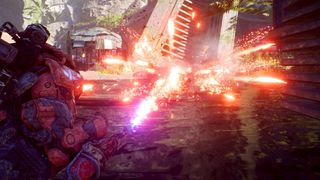Best Anthem gear: how to customize your javelin's build
Suit up

So Anthem has four different Javelins, each of which involves a playstyle of its own. While each Javelin is predisposed towards different weapons, they’re also equipped with a unique range of other gear, allowing for customization of playstyles beyond just having two weapon slots available.
By gear, we don’t necessarily mean armor. In fact, each Javelin only has two sets of armor available to unlock at the moment, meaning that there’s not a lot of room for experimentation aside from purely aesthetic endeavors.
As a result, we need to look a little closer at what we can do to have more of an impact in-game. That’s why it’s worth examining each Javelin’s abilities and equipment individually - so we can discover what works best and apply that to our own experience as a Freelancer.
Interceptor

The Interceptor is Anthem’s melee Javelin, and a lot of its playstyle revolves around its Double-Bladed Daggers ability. However, the Interceptor is unique for more than just that, because it has three different grenade slots.
These slots are separated based on the role they’re supposed to perform: strike, assault, and support. While each individual category has a range of options to choose from, you also need to consider what your build is like overall, meaning that you’ll need to synergize your individual choices into a cohesive whole. Luckily, that’s not as difficult to do as it sounds, and there are already some common Interceptor grenade builds that have proven to be incredibly powerful.
For example, the Interceptor’s Target Beacon - from its support category - marks a specific enemy, debuffing them and making them take an increased amount of damage from you and your team. You can throw your Venom Bomb, from assault, into the mix too, which actually works as a primer. If you’ve got a Storm or a Colossus on your team, they can trigger some massive detonations against vulnerable, primed enemies. If not, you can actually just engage yourself with Tempest Strike, a strike ability.
This will allow you to target a specific enemy and quickly build up a melee combo, allowing you to detonate your own primer and deal massive damage, while simultaneously stunning nearby enemies.
Get daily insight, inspiration and deals in your inbox
Get the hottest deals available in your inbox plus news, reviews, opinion, analysis and more from the TechRadar team.
Colossus

Gear is particularly important in relation to Colossus builds, as their access to heavy artillery offers them a plethora of big guns to choose from. Some of these are far better than others, so it’s best to aim for specific strategies if you want to maximize your impact as your team’s lean, mean, tanking machine.
If you’re familiar with the Colossus, using Battle Cry is a good idea. This is your Taunt ability that makes you the center of attention, drawing enemy fire away from your teammates. If your teammates are good, they’ll capitalize on this before you so much as scratch your armor. If not, you may be left in desperate need of revival faster than you can say, “I should have used Shield Pulse.” This ability is pretty great too, as it decreases damage received for your entire team over a short period of time, but if you really want to make your mark as a Colossus main, Battle Cry is a risk worth taking.
As for your big guns; our favorite combo is definitely the Firewall Mortar and the Siege Cannon. Running these two together allows you to prime enemies for your Storms and Interceptors, while also affording you the potential to aim your literal cannon at enemies ripe for detonating. The Siege Cannon is pretty inaccurate at times, and it can be tough to hit mobile enemies, but landing a slug will do devastating damage against an enemy, especially if they’re primed. Also, it has one of the best gun-feels in the game, especially when you actually manage to connect with a detonation.
The Firewall Mortar makes it really easy to unleash massive combos on a large group of enemies too, as it helps to confine them to a single area. You can actually see where your fire is going to ignite before you shoot, so you can really line this one up with finesse.
Ranger

Rangers are the most versatile Javelins in Anthem, and their gear reflects this fact. You can run melee builds, sniper builds - pretty much anything that isn’t unique to the Colossus. However, due to the Ranger’s status as the most gun-oriented Javelin, it’s probably best to commit to a build that prioritizes damage output.
With this in mind, you’ll want to start off by ensuring that your Ranger is equipped with Frost Grenades. These are an ice primer, which adds to your ability to prime targets with elemental damage that your Shock Mace melee ability already affords you. As for your wrist launcher, many people argue that Venom Darts are the strongest choice, but ideally you want a detonator here and a primer in your grenade slot.
Grenades hit a larger surface area and have the potential to prime several enemies at once, taking accuracy out of the equation and lining up massive combo potential for a Storm hovering overhead. As opposed to running Venom Darts, you should consider Pulse Blast, which is a powerful detonator that targets a single enemy. You can use this against enemies you prime yourself, or capitalize on an enemy primed by one of your teammates.
Both support abilities for the Ranger are pretty strong, so you should choose one based on your playstyle. If you’re an aggressive Ranger, Muster Point will allow you to deploy a zone from which you can deal increased damage, which also buffs teammates standing within its radius. If you’re more of a defensive, area-control type, Bulwark Point creates a shield that allows you to make your own microcosmic arena within the larger fight. It’s essentially area denial, as enemies have to engage you within its radius if they’re going to deal any damage to you. If you’ve got your Colossus and Interceptor inside, you’ll be able to make the enemies come to you, allowing your close combat Javelins to really maximize their damage output.
Storm

The Storm is Anthem’s most ability-oriented Javelin, and its gear is constituted by three kinds of Seals: Blast, Focus, and Support.
Your job as a Storm is to control crowds and set up combos. As a result, you’ll likely be making use of your ability to hover for an extended period of time by looking down on the fight from above, picking out combos and providing relief for teammates who might be in a pinch.
The best Storm loadouts consist of primer Blast Seals and detonator Focus Seals. For example, using Ice Storm as your Blast Seal will allow you to freeze enemies across a massive area of effect, all of whom will be both primed and frozen in place. Teammates can then aim for weak points or critical hits with detonators, allowing maximum combo returns and potentially dealing thousands of damage. If you want to detonate these combos yourself, you should have Burning Orb equipped as your Focus Seal. This allows you to shoot a group of small, flaming orbs, or charge up a massive fireball that you can unleash in one go. You can clean up a range of primed targets with the former, whereas the latter can be used to deal devastating damage to larger enemies.
As for support seals, again it’s almost entirely up to you. Nexus reduces cooldowns for your teammates and can be useful in terms of increasing overall damage-per-second output, but Wind Wall provides a similar kind of defensive affordance to the Ranger’s Bulwark Point. Due to your offensive playstyle, it’s probably best to keep Wind Wall equipped in case you’re tasked with a last-ditch attempt at reviving a fallen teammate, or need to duck out of the action for a minute to regain health.
Most of all though, gear is designed for synergy. So although you might think you’re doing your team a favor by going out with all primers, you’re not actually being a good samaritan - you need to be versatile so that you can both prime and detonate combos. That’s why all of the above gear loadouts prioritize versatility and survivability - Anthem is a team game, after all!
(Image credits: BioWare/EA)
Cian Maher is the associate Editor at TheGamer. He is a freelance reporter with work in The Guardian, The Washington Post, Techradar, The Irish Times, The Verge, VICE, WIRED, Ars Technica, MTV, Eurogamer, VG247, Polygon, GameSpot, Rock Paper Shotgun, IGN, Variety, Red Bull, Gamasutra, PC Gamer, SYFY, and more. First Class Honours BA in English Studies from Trinity College Dublin.

